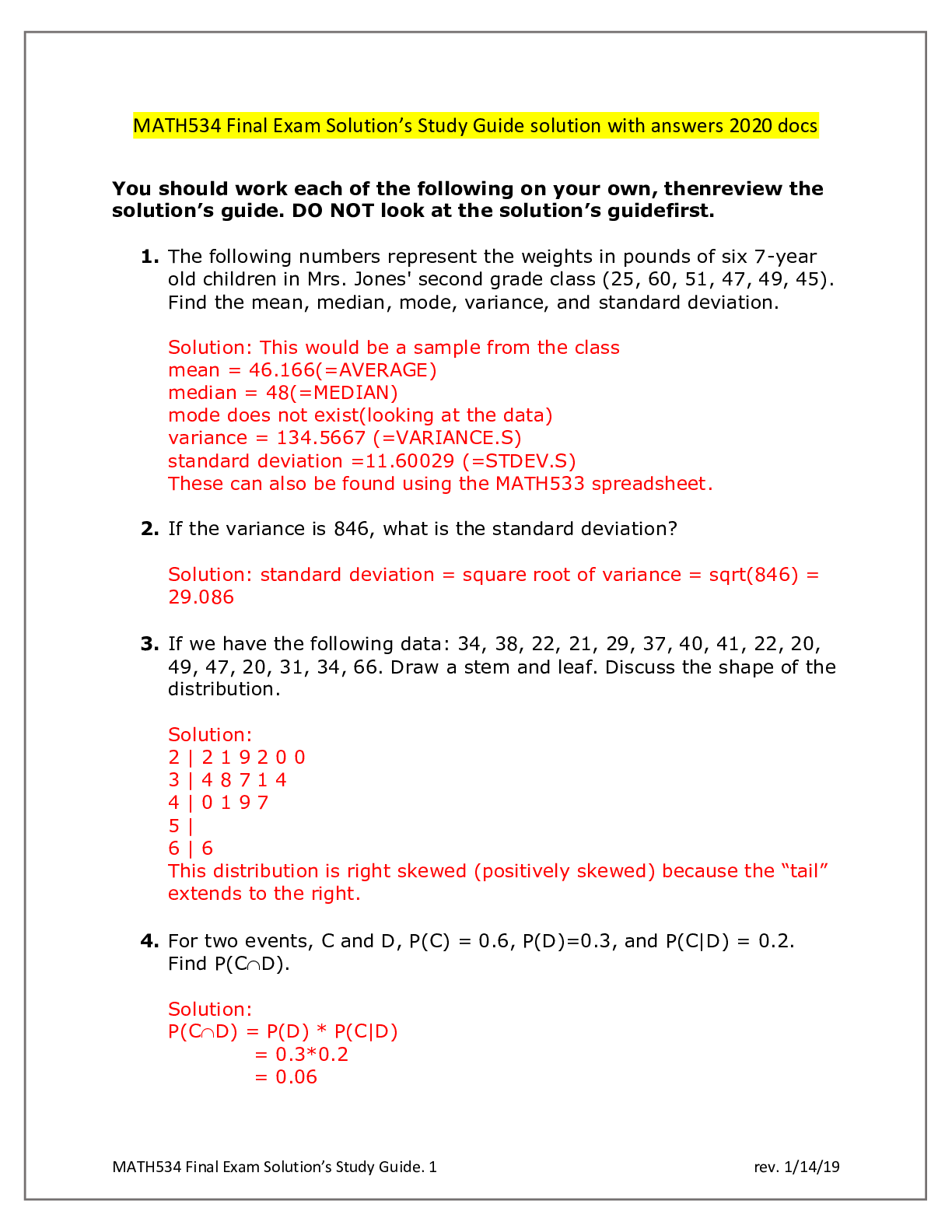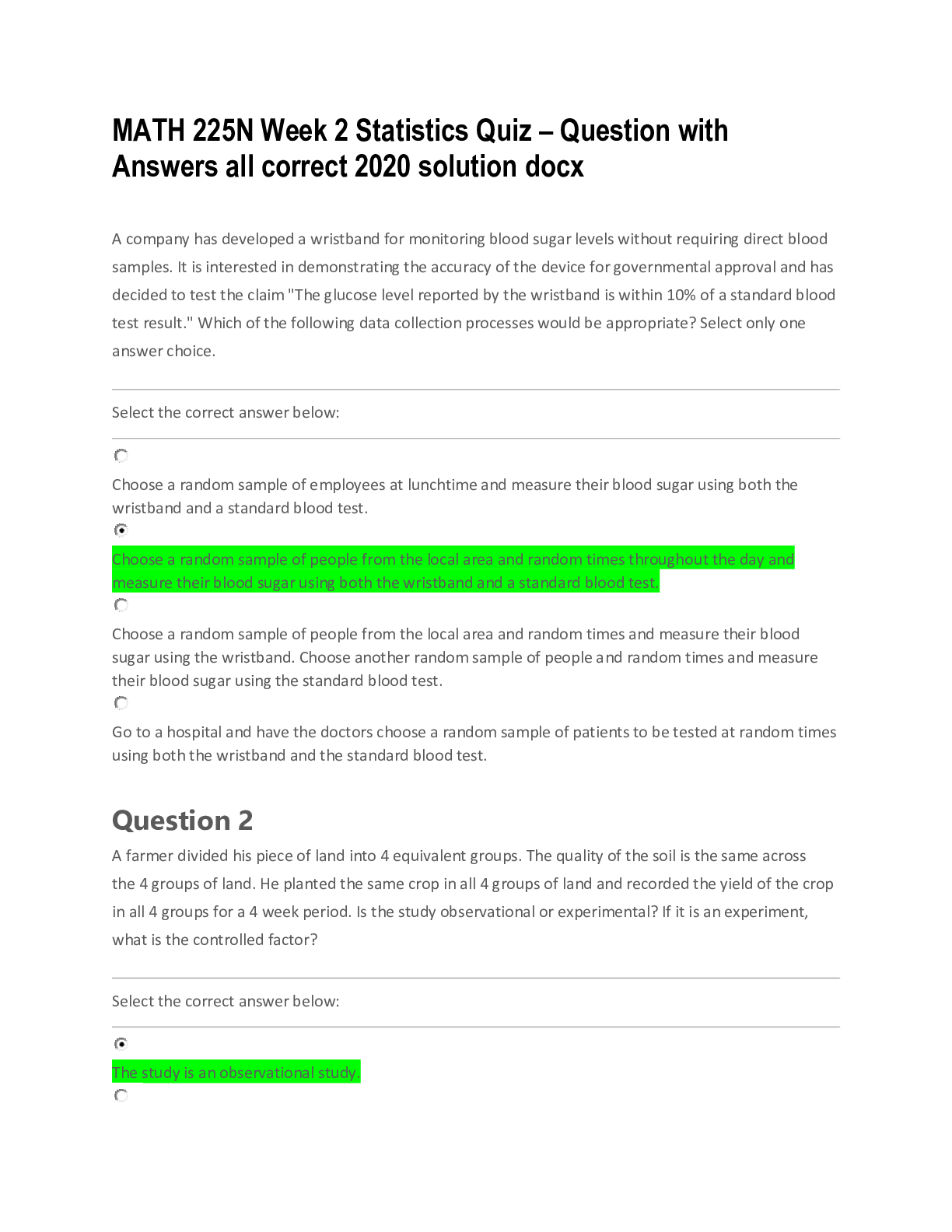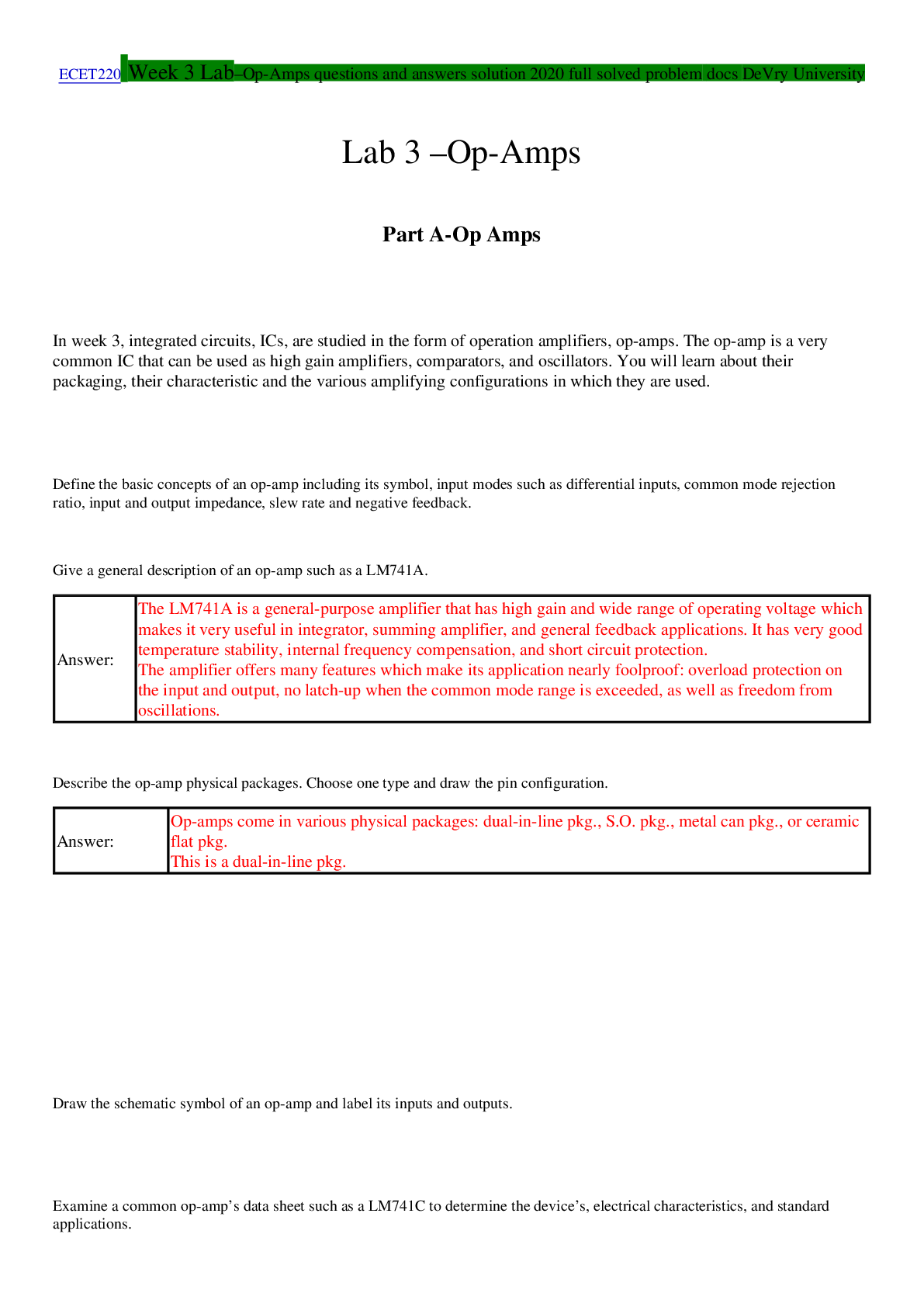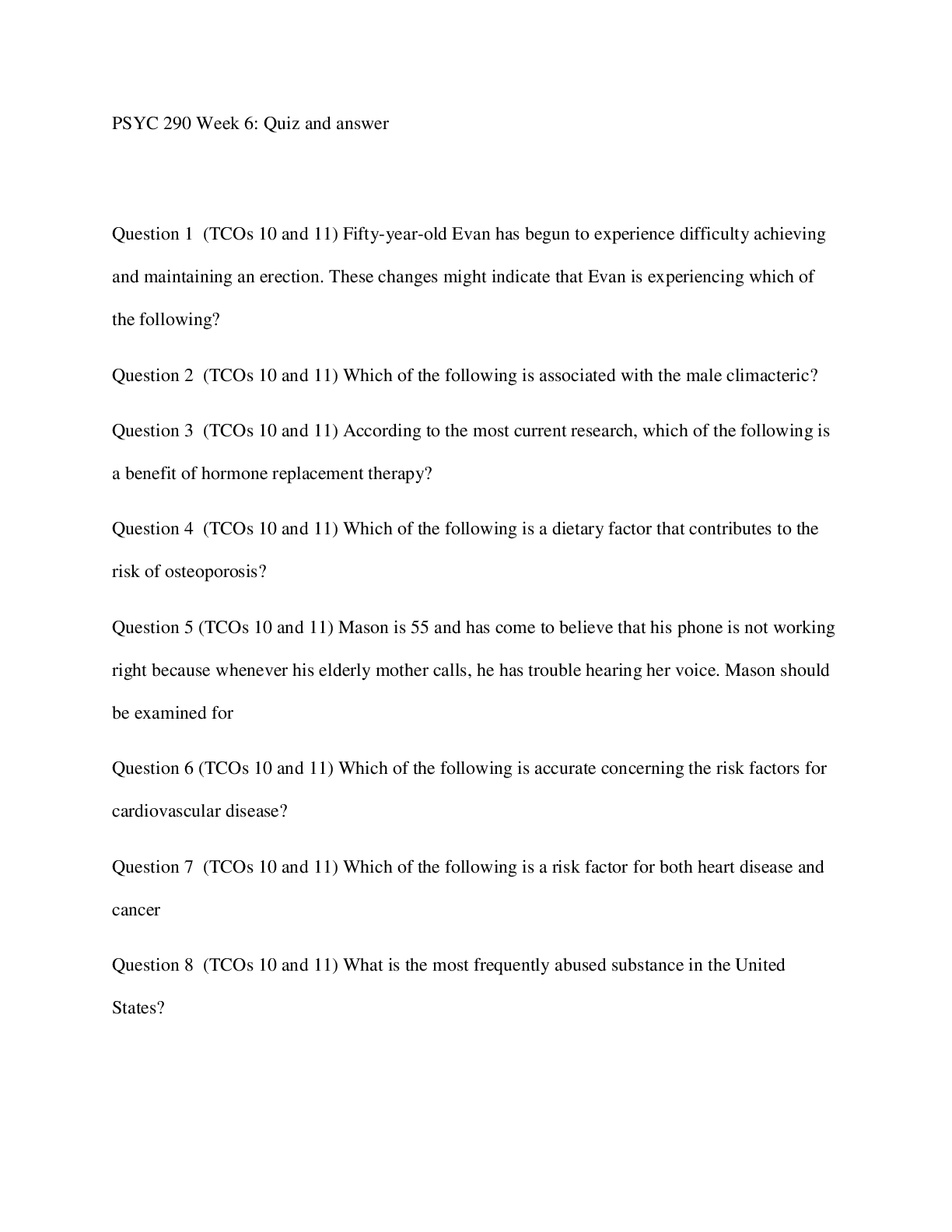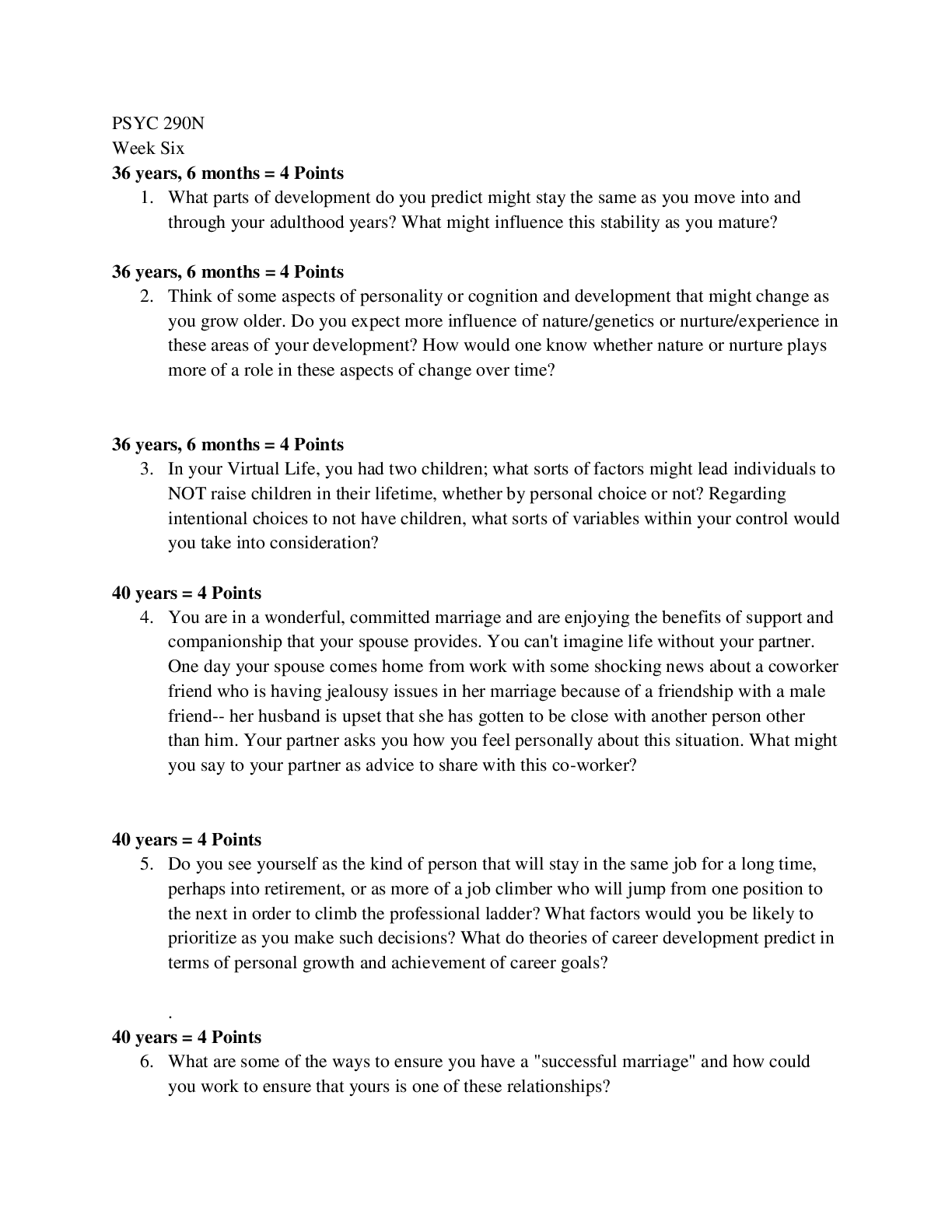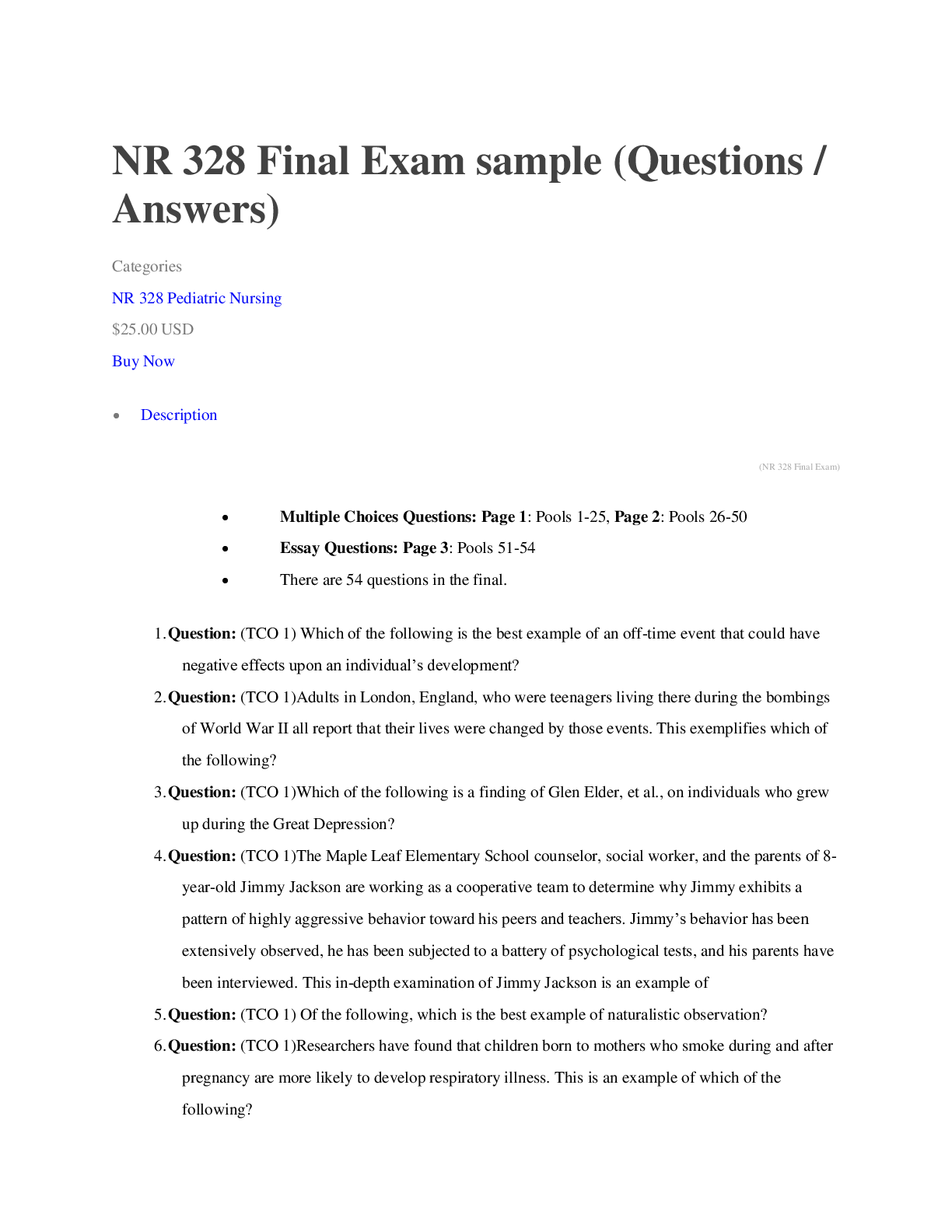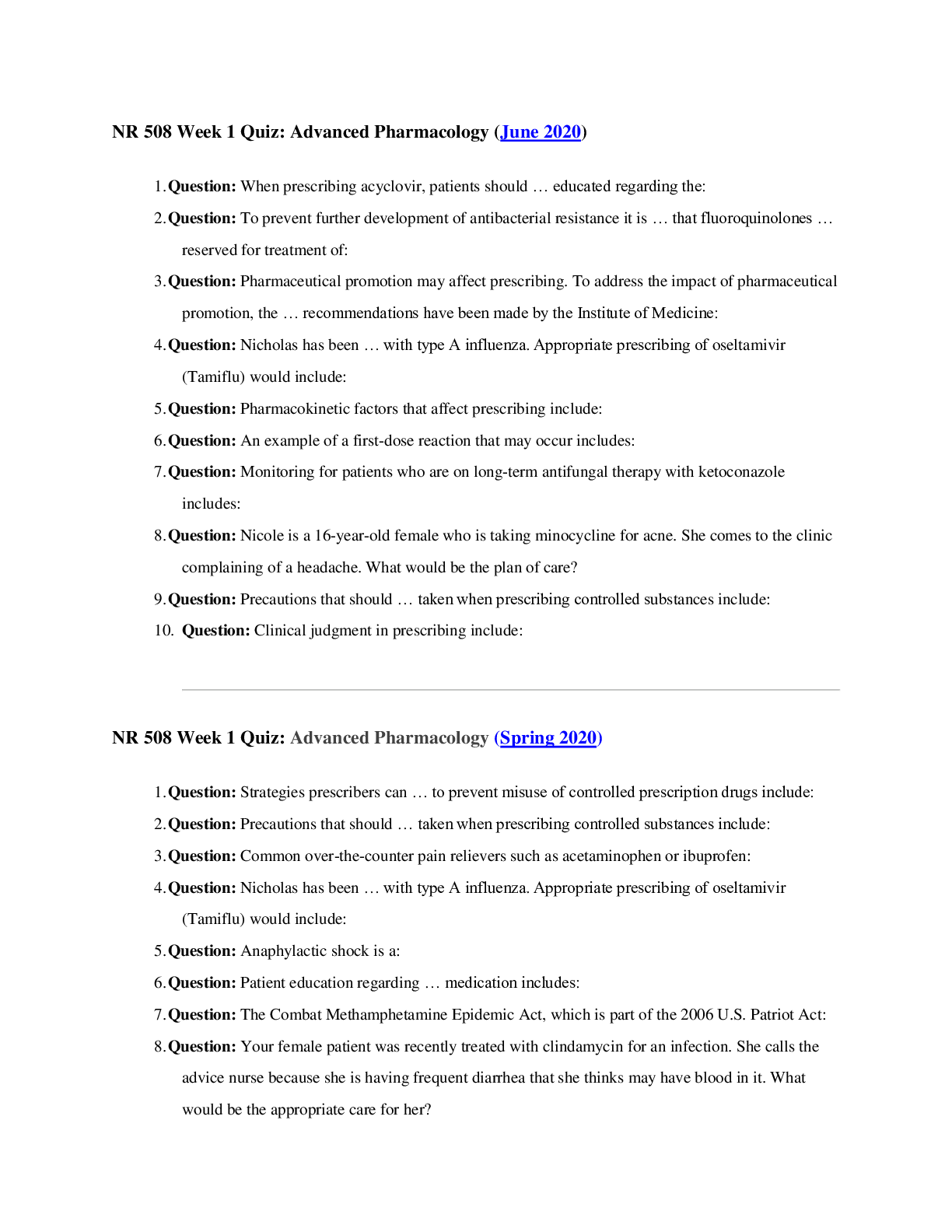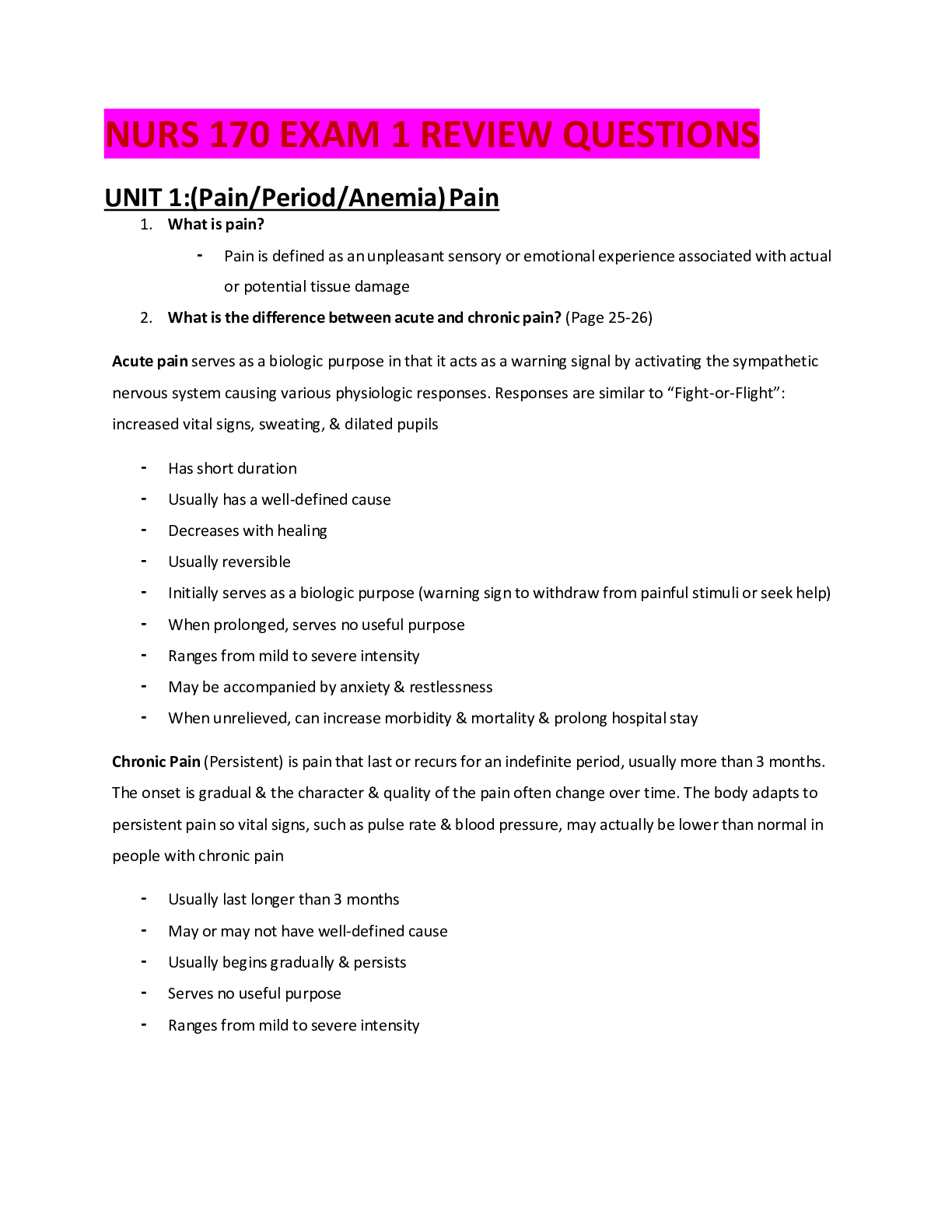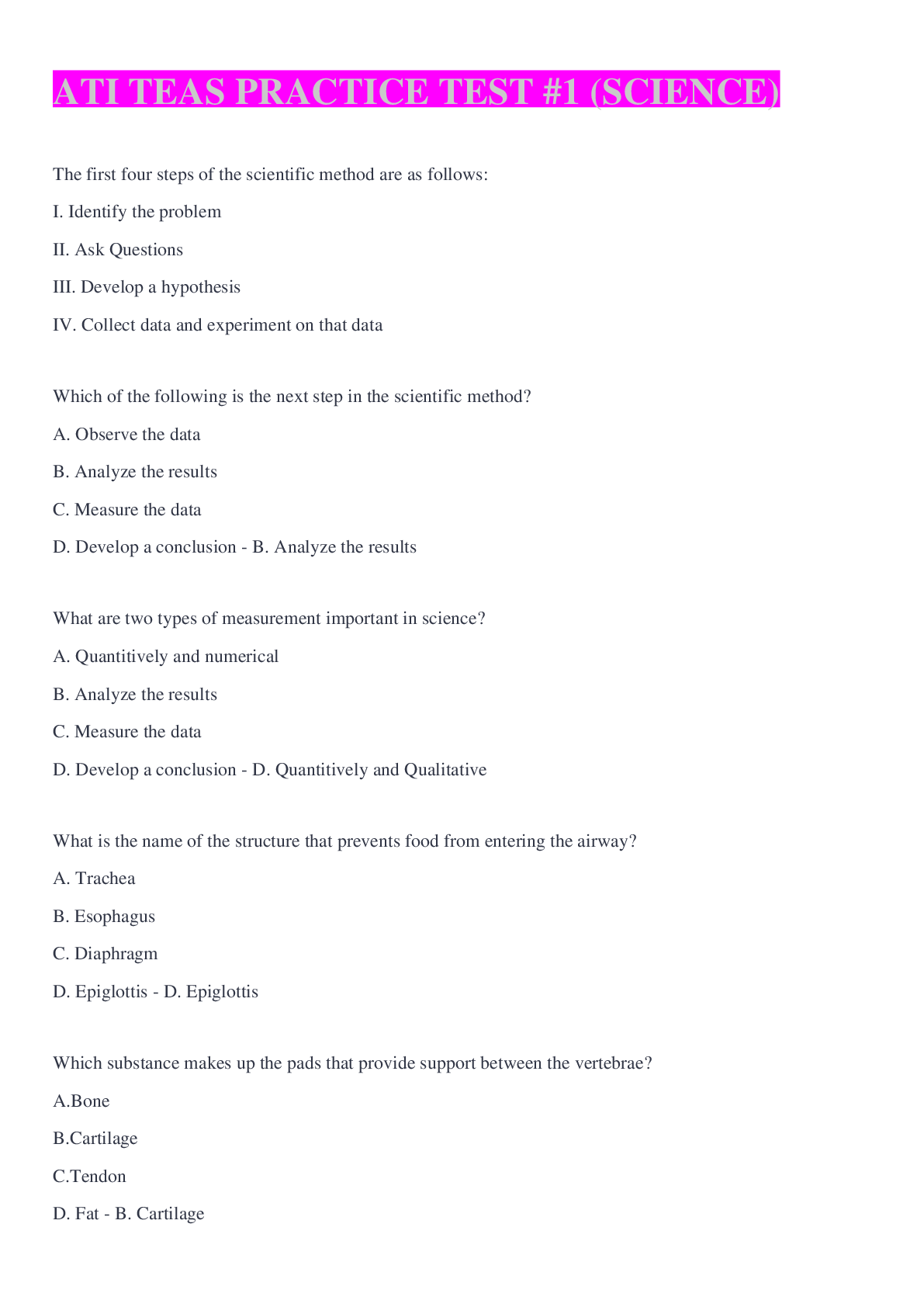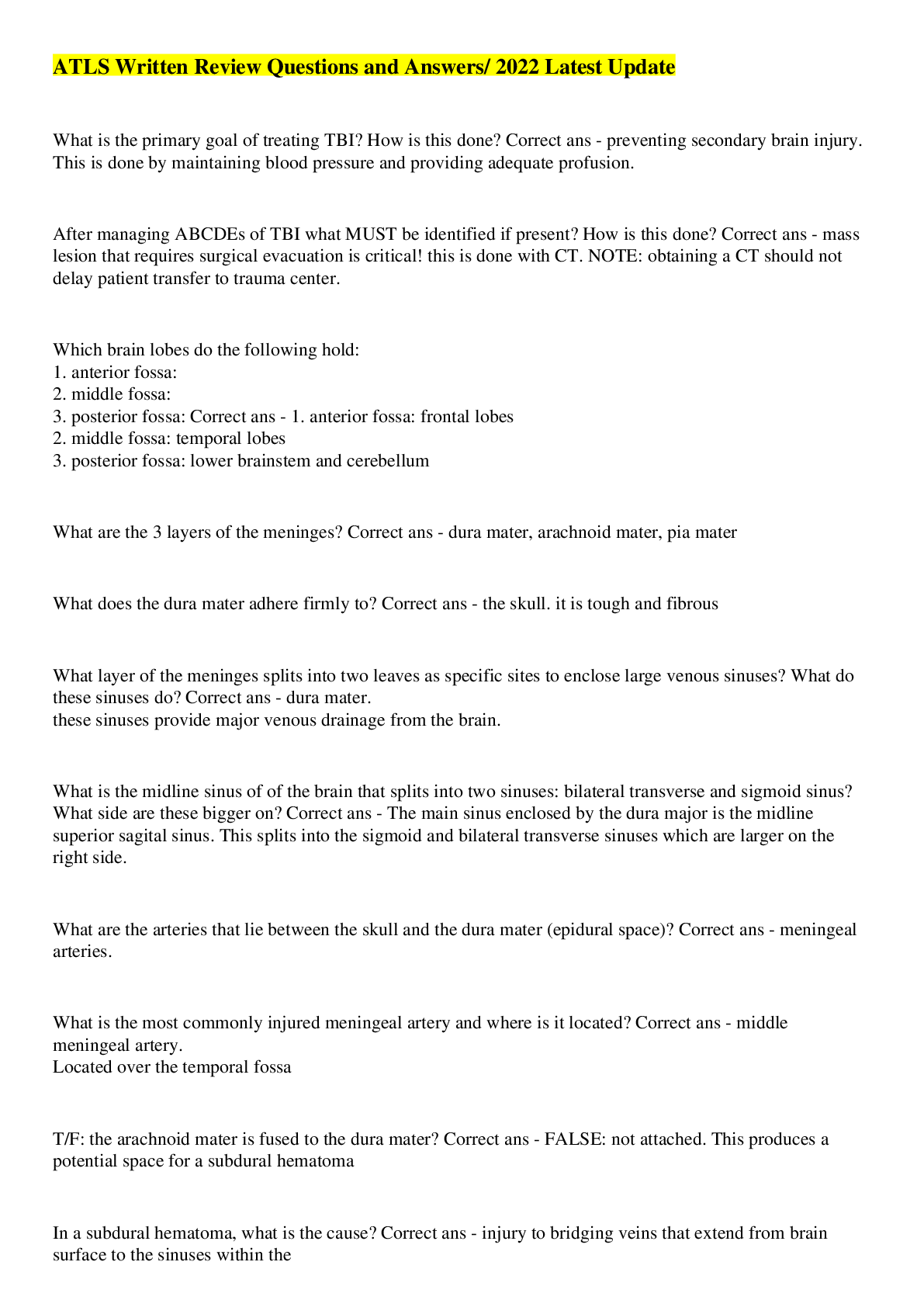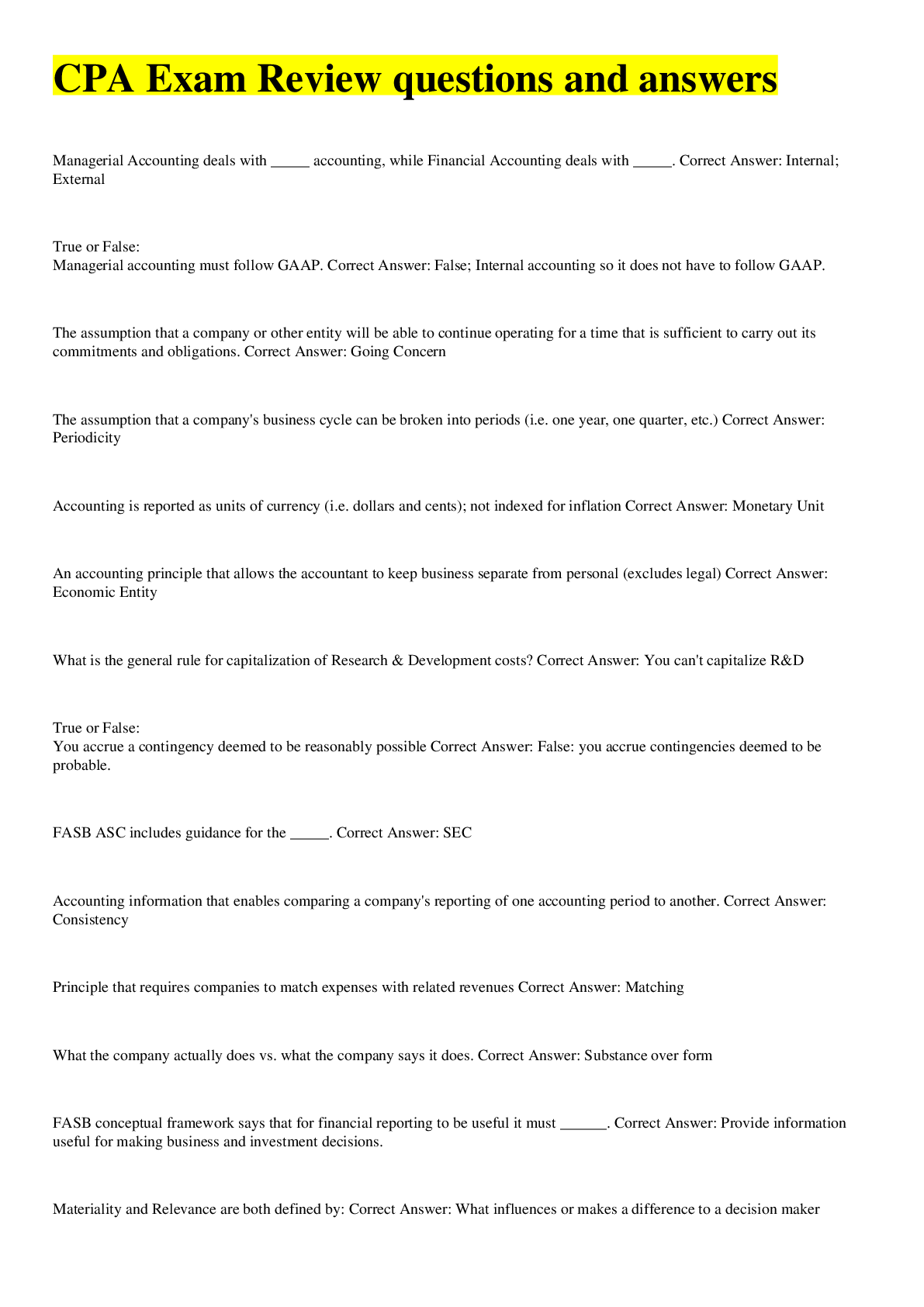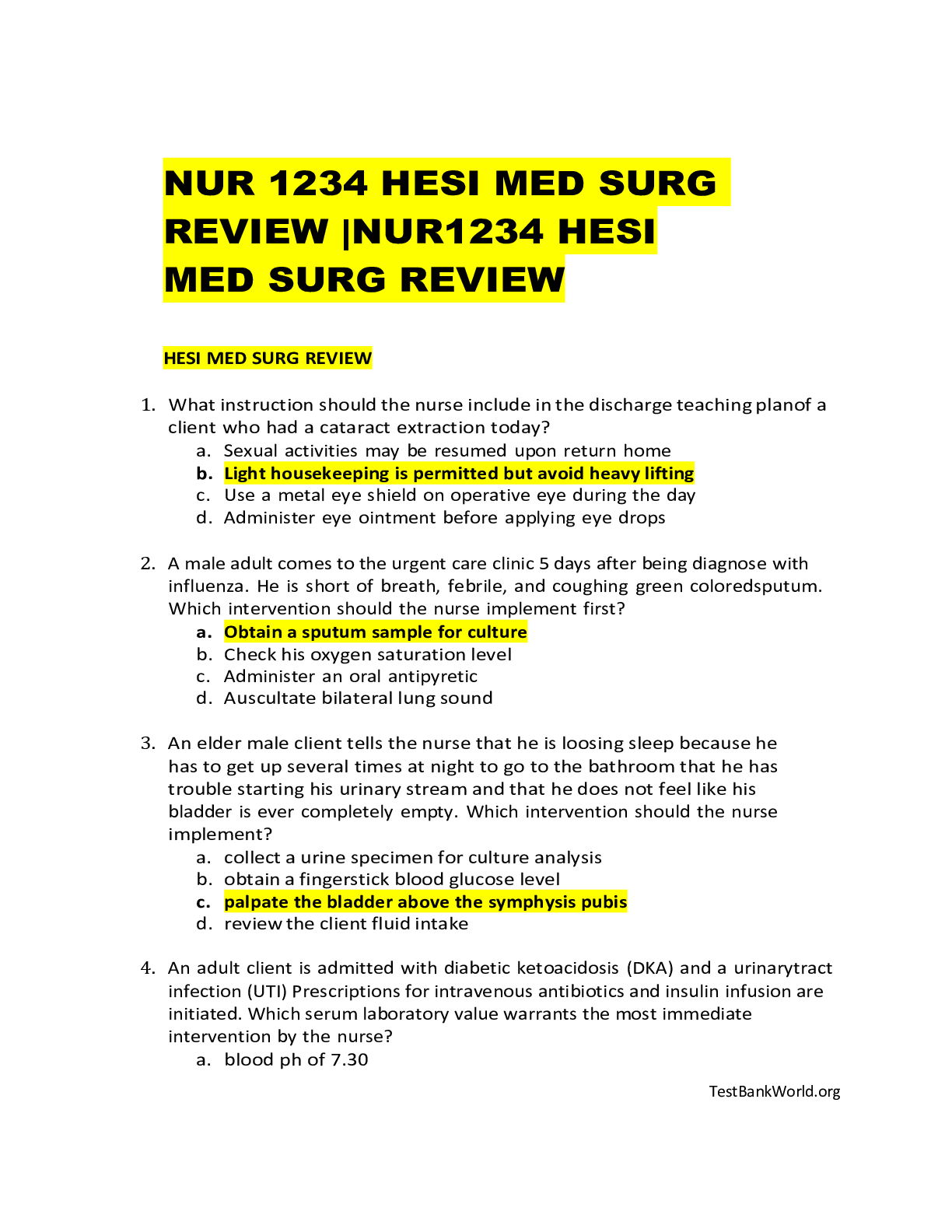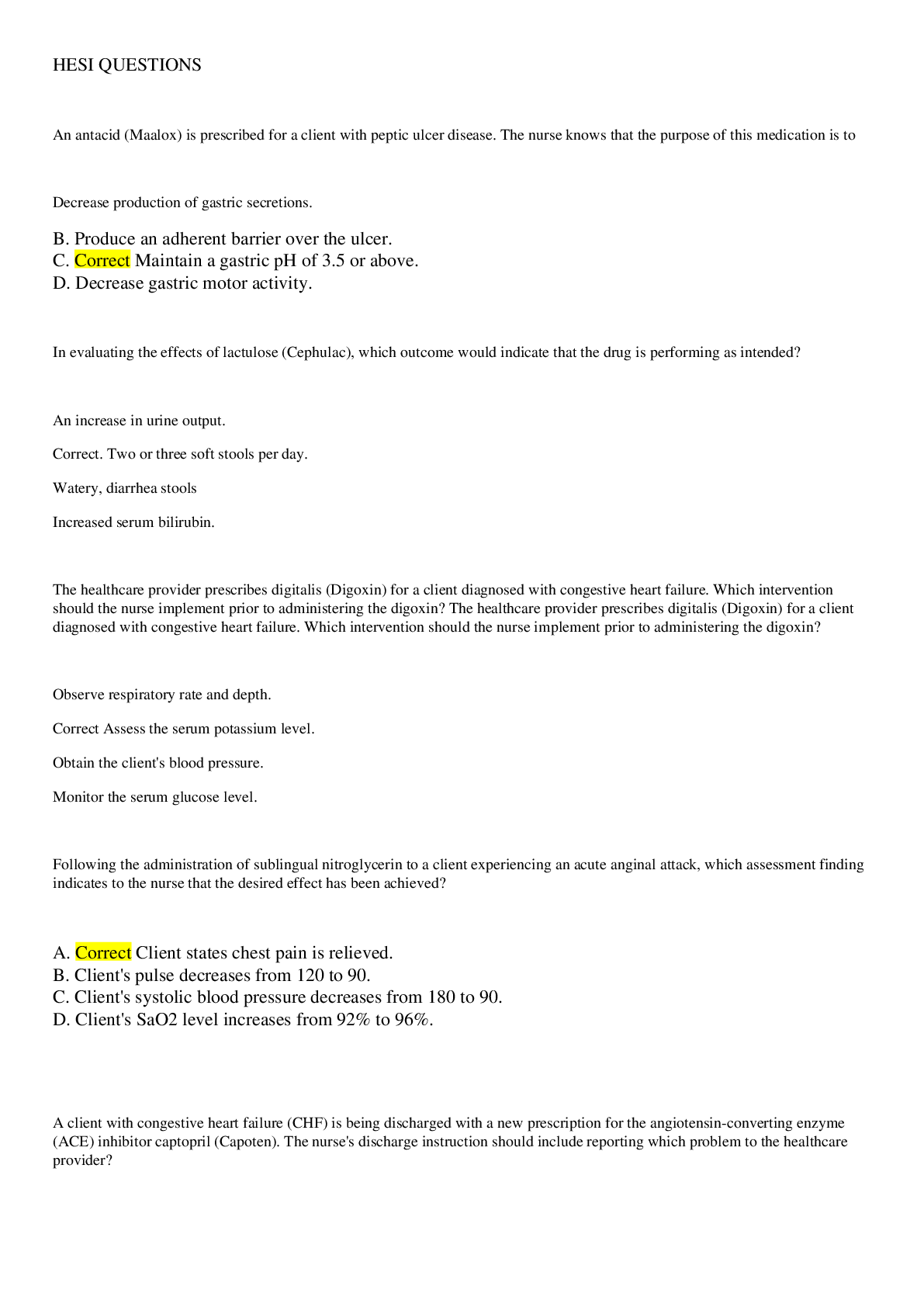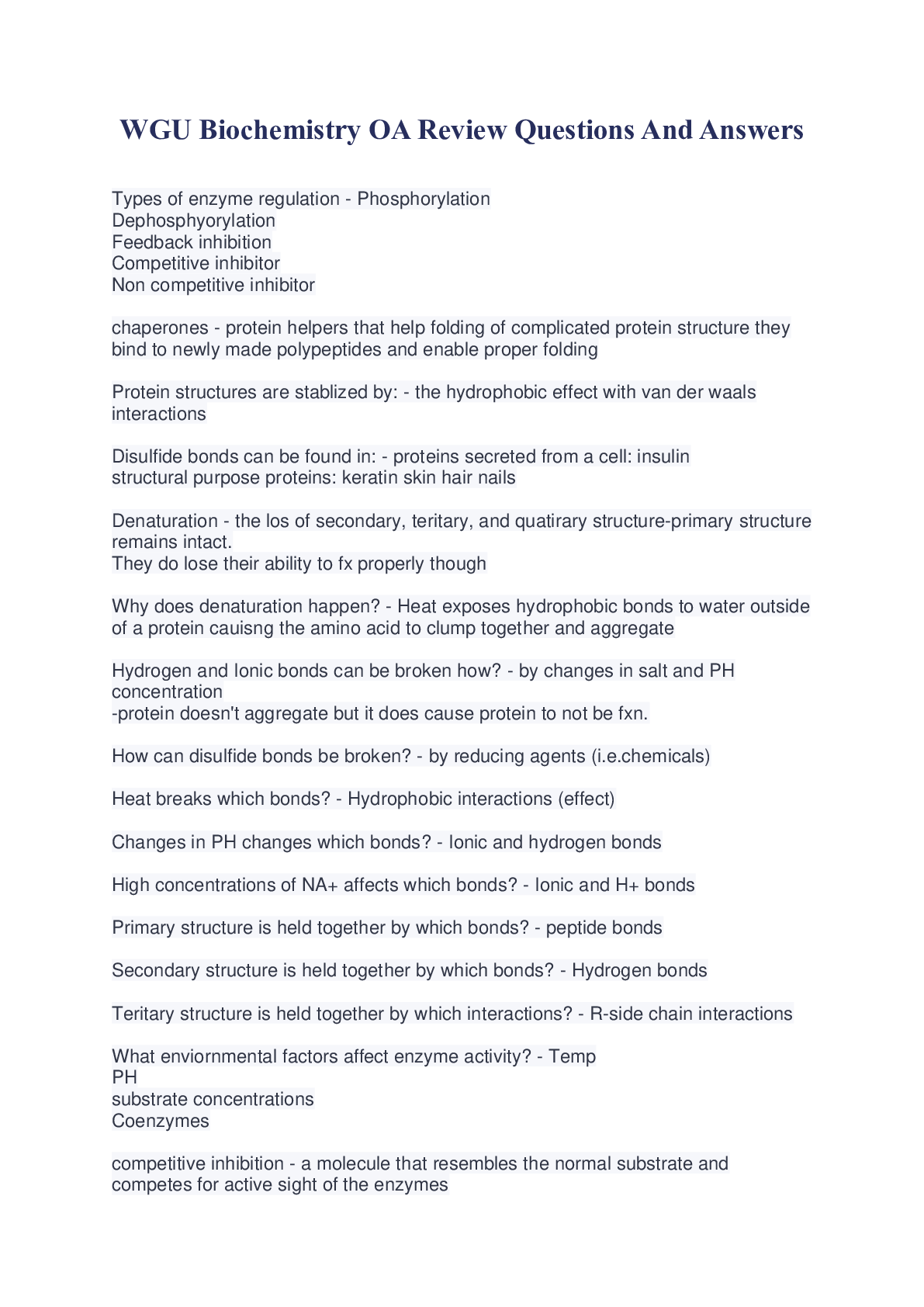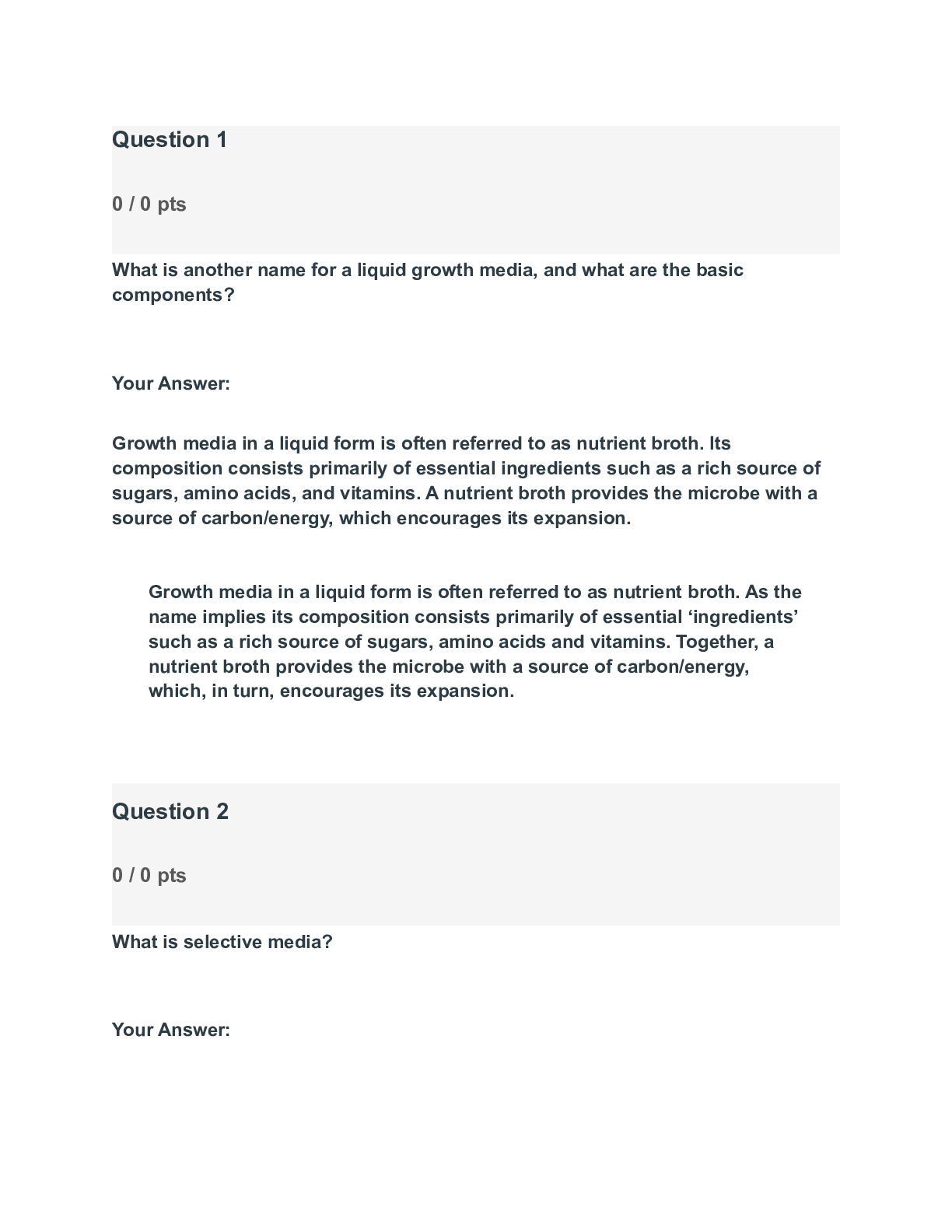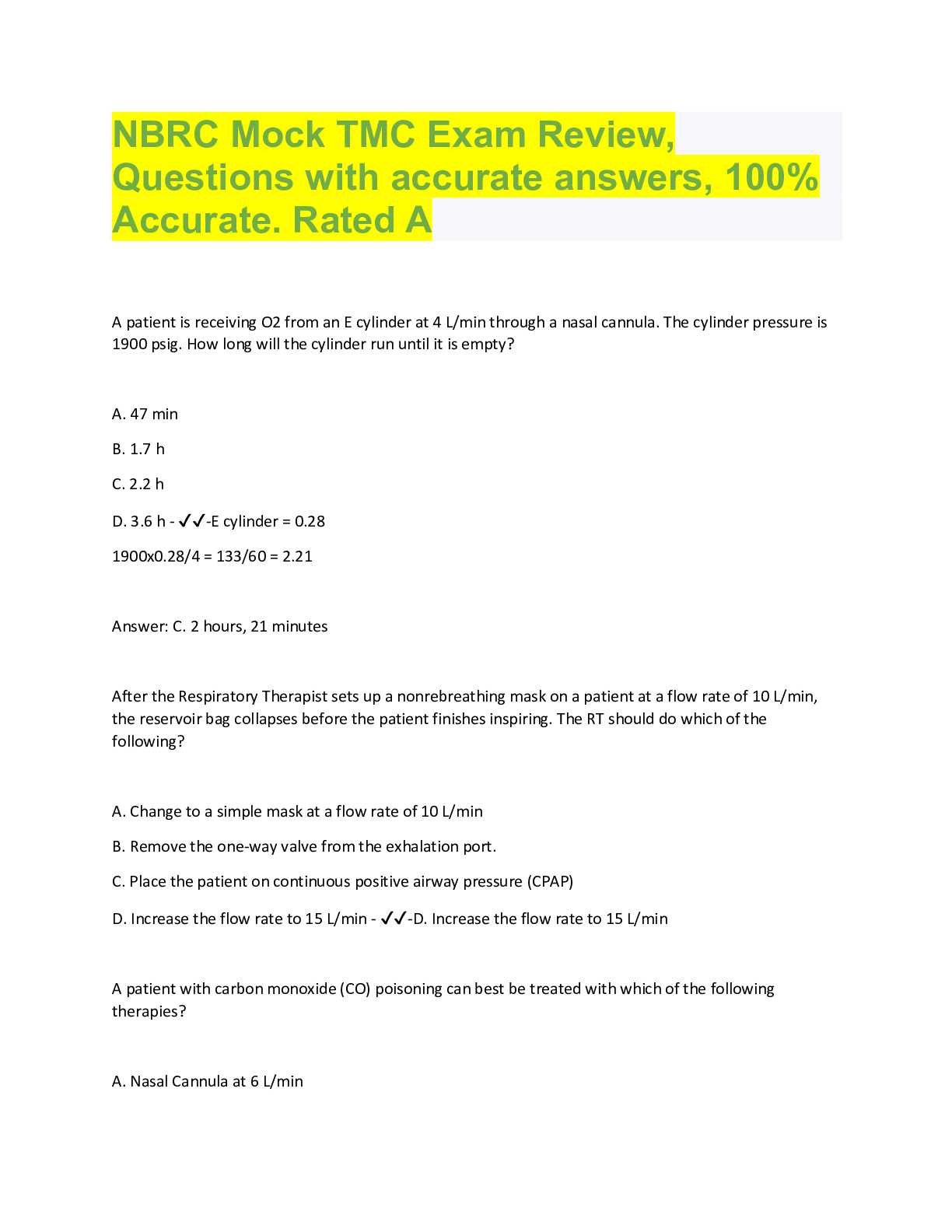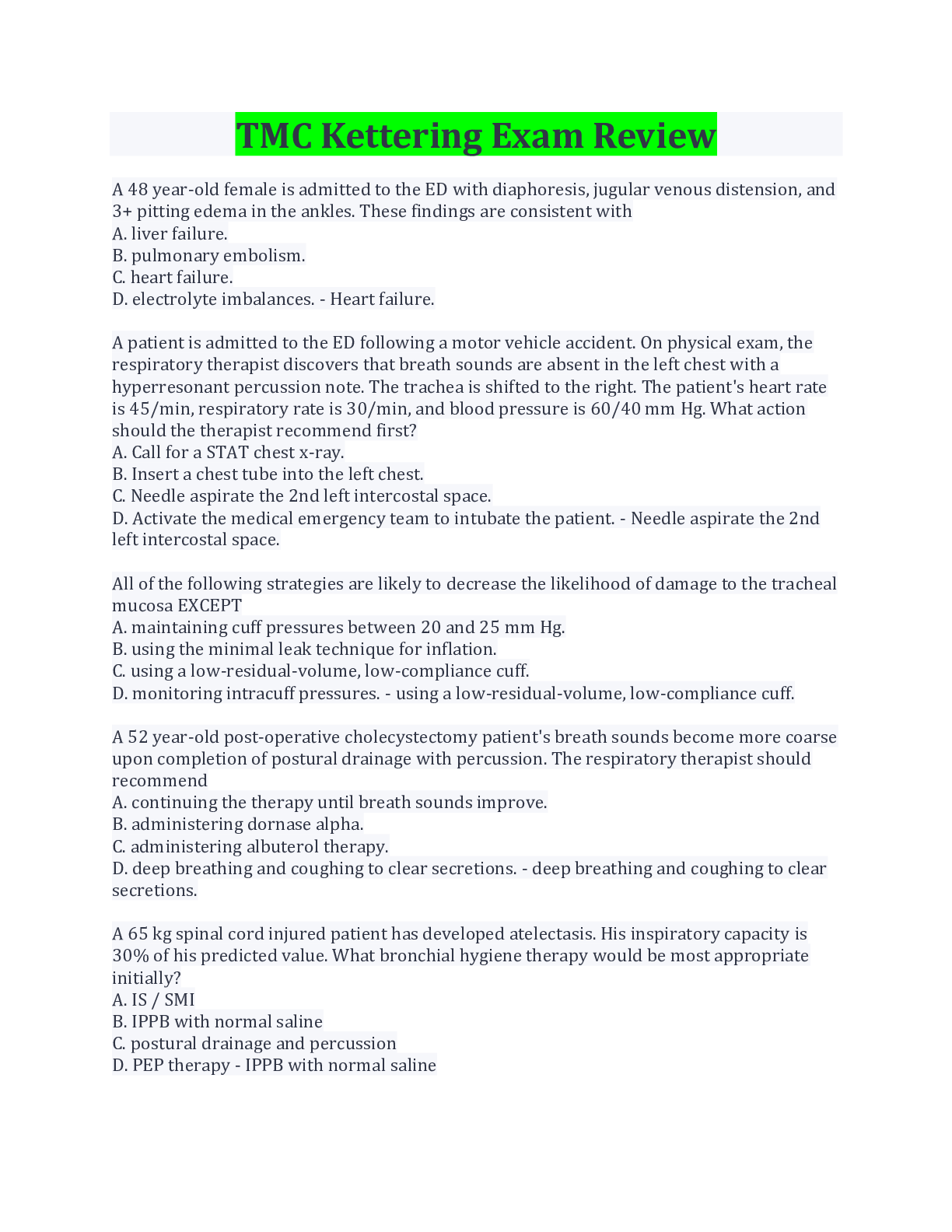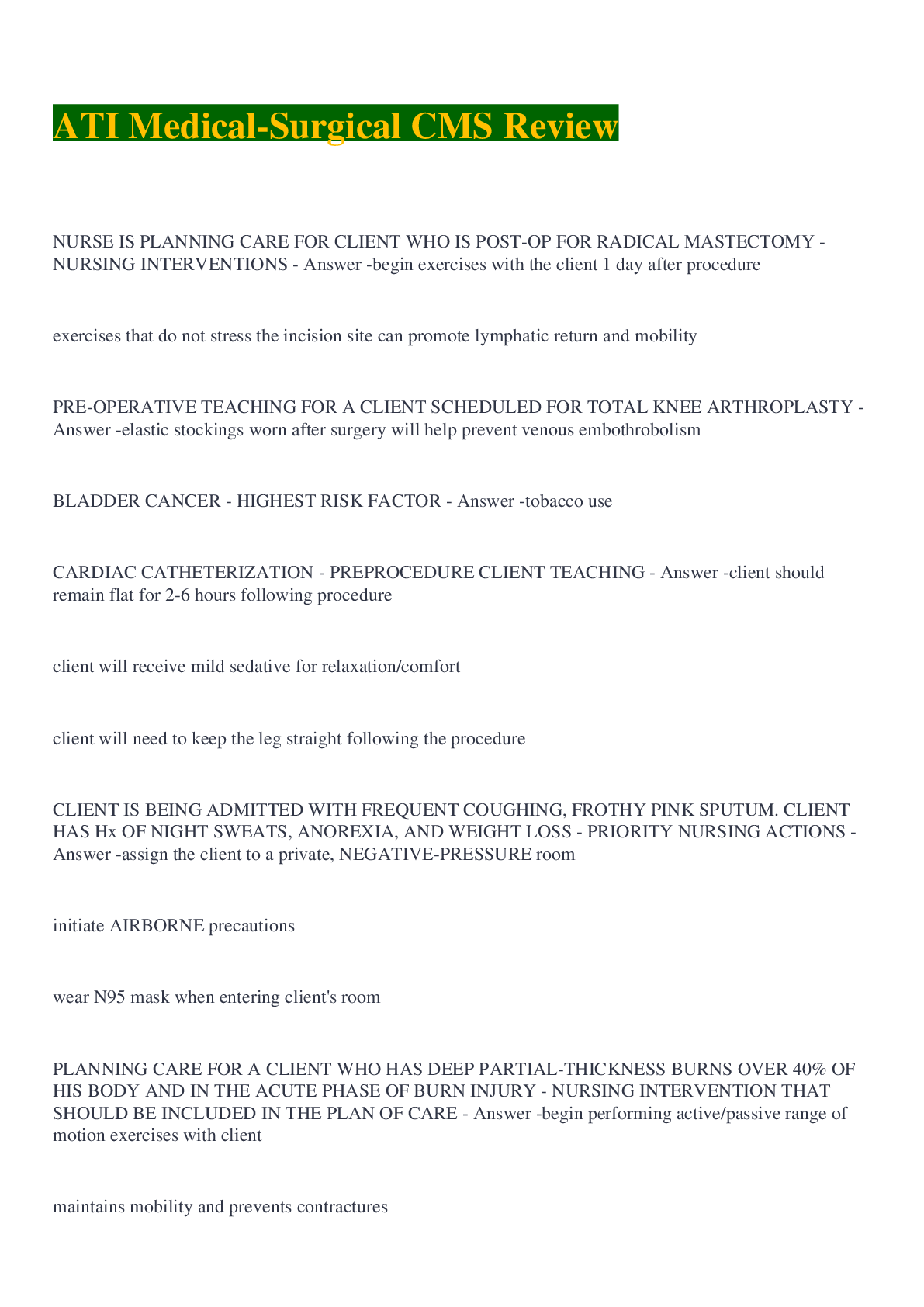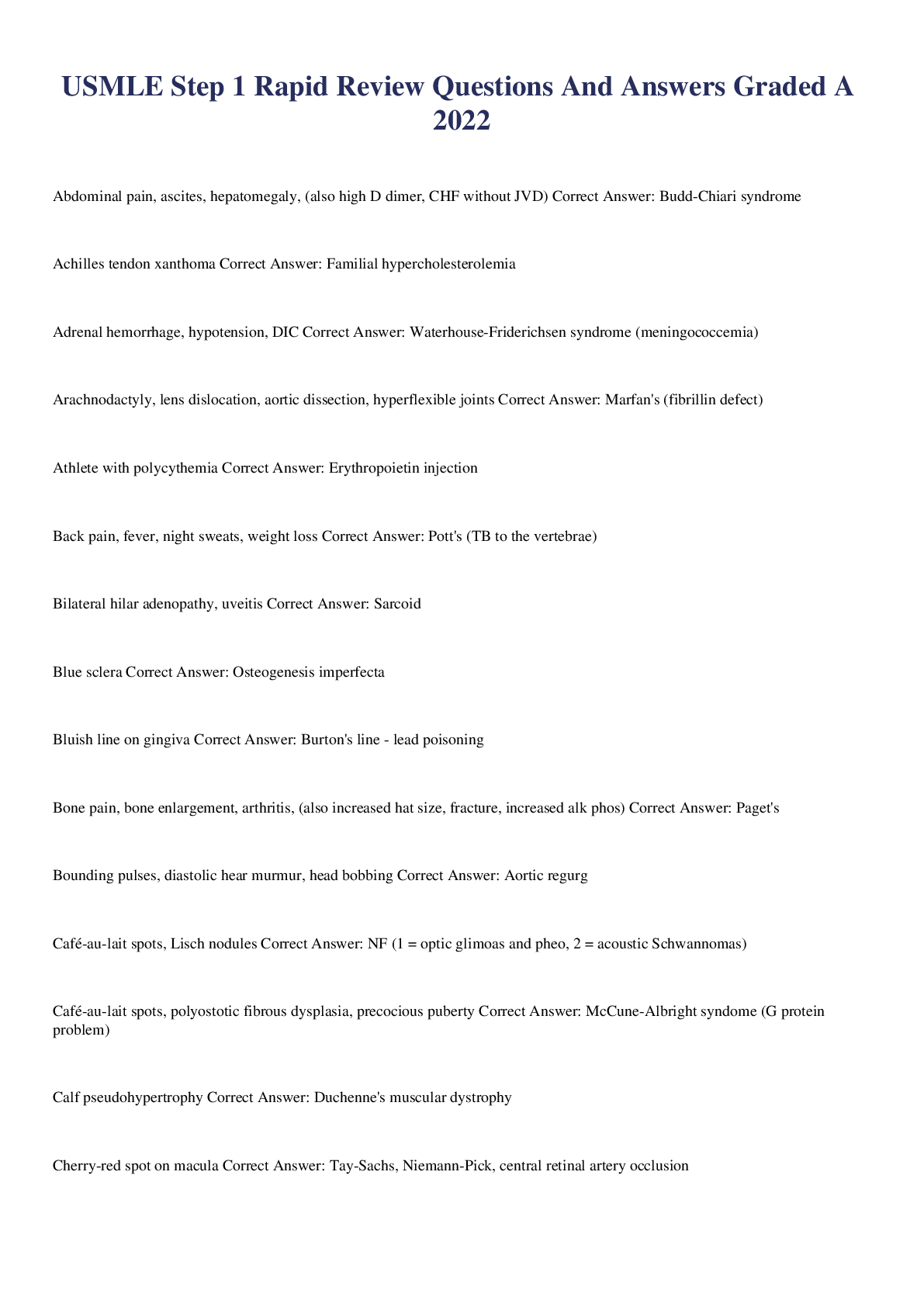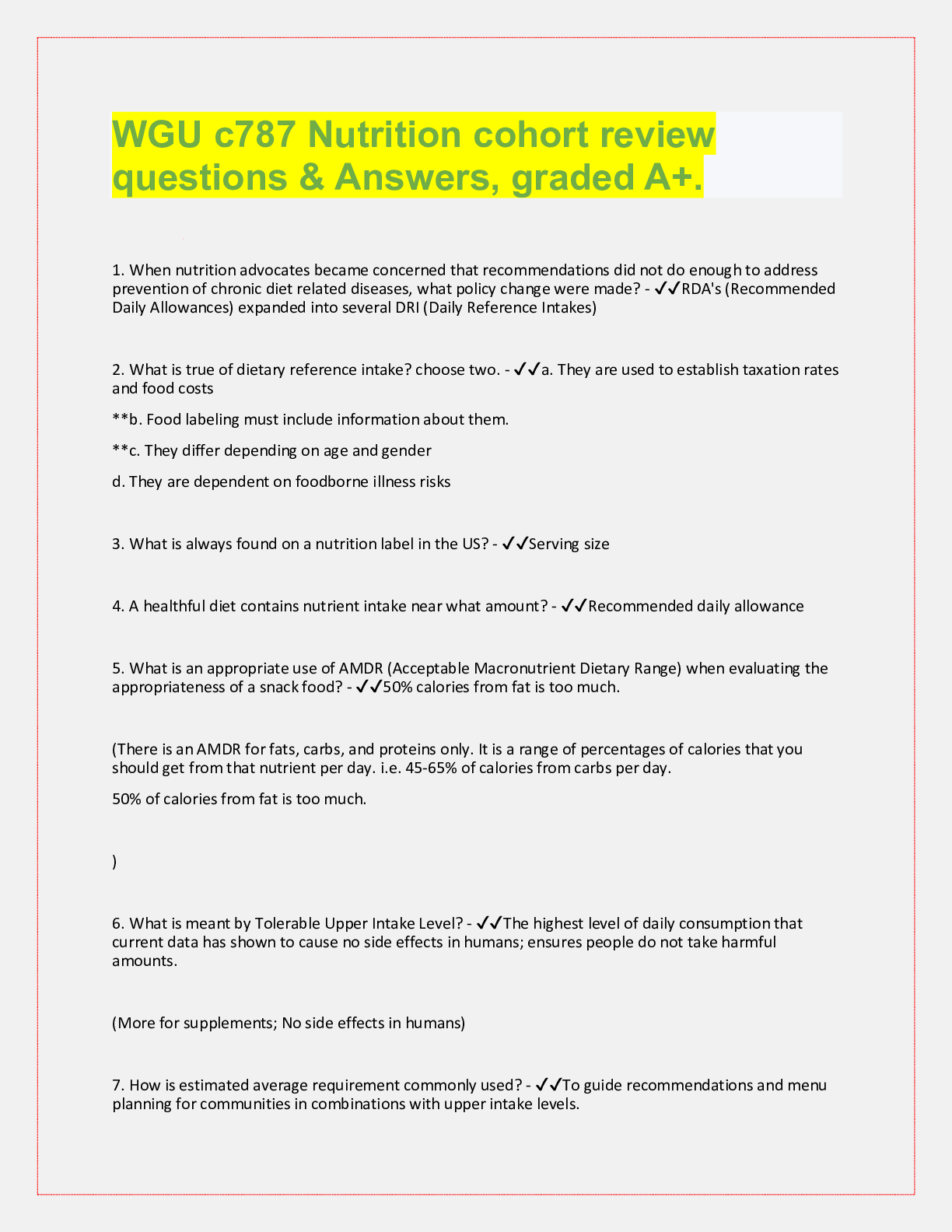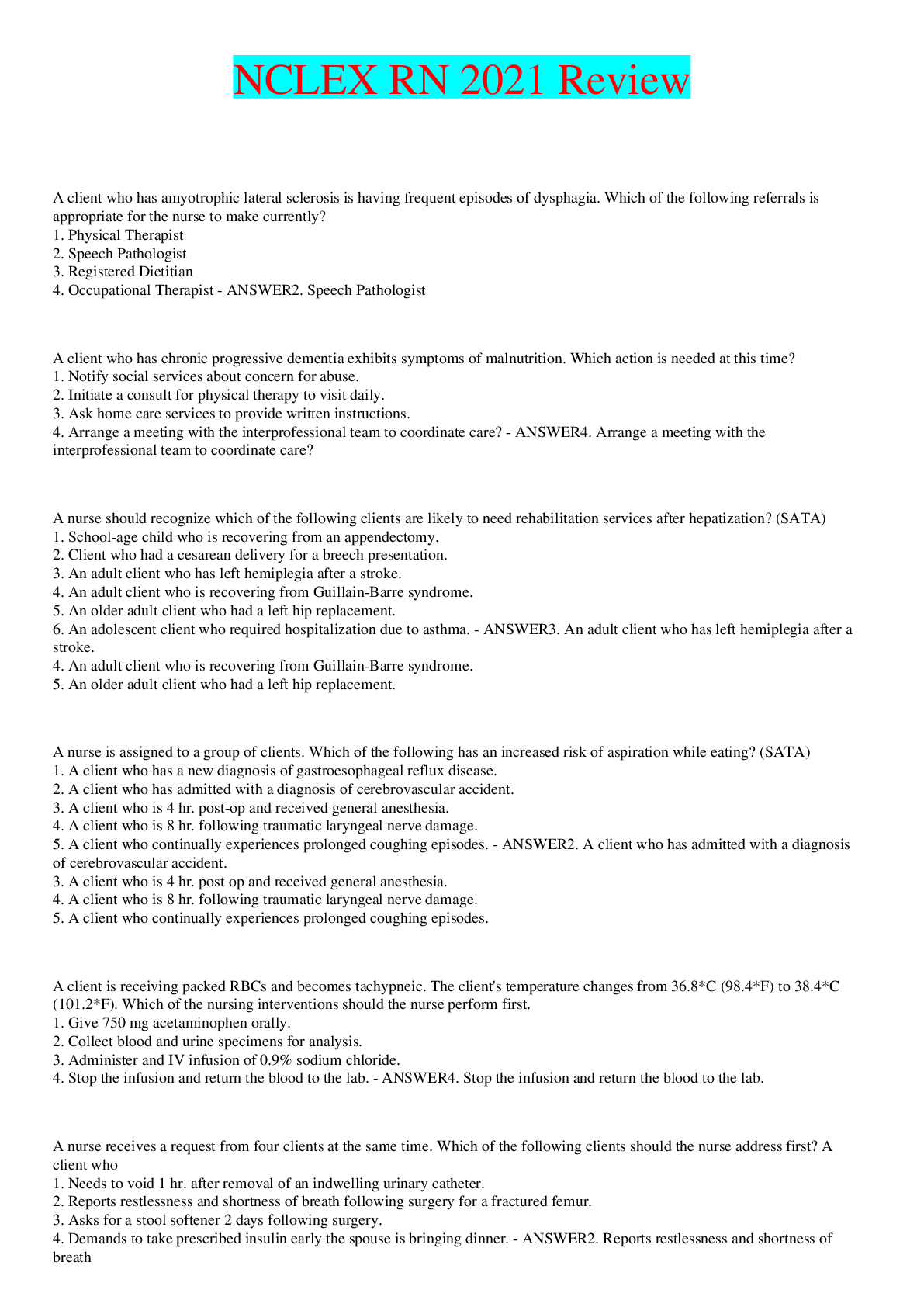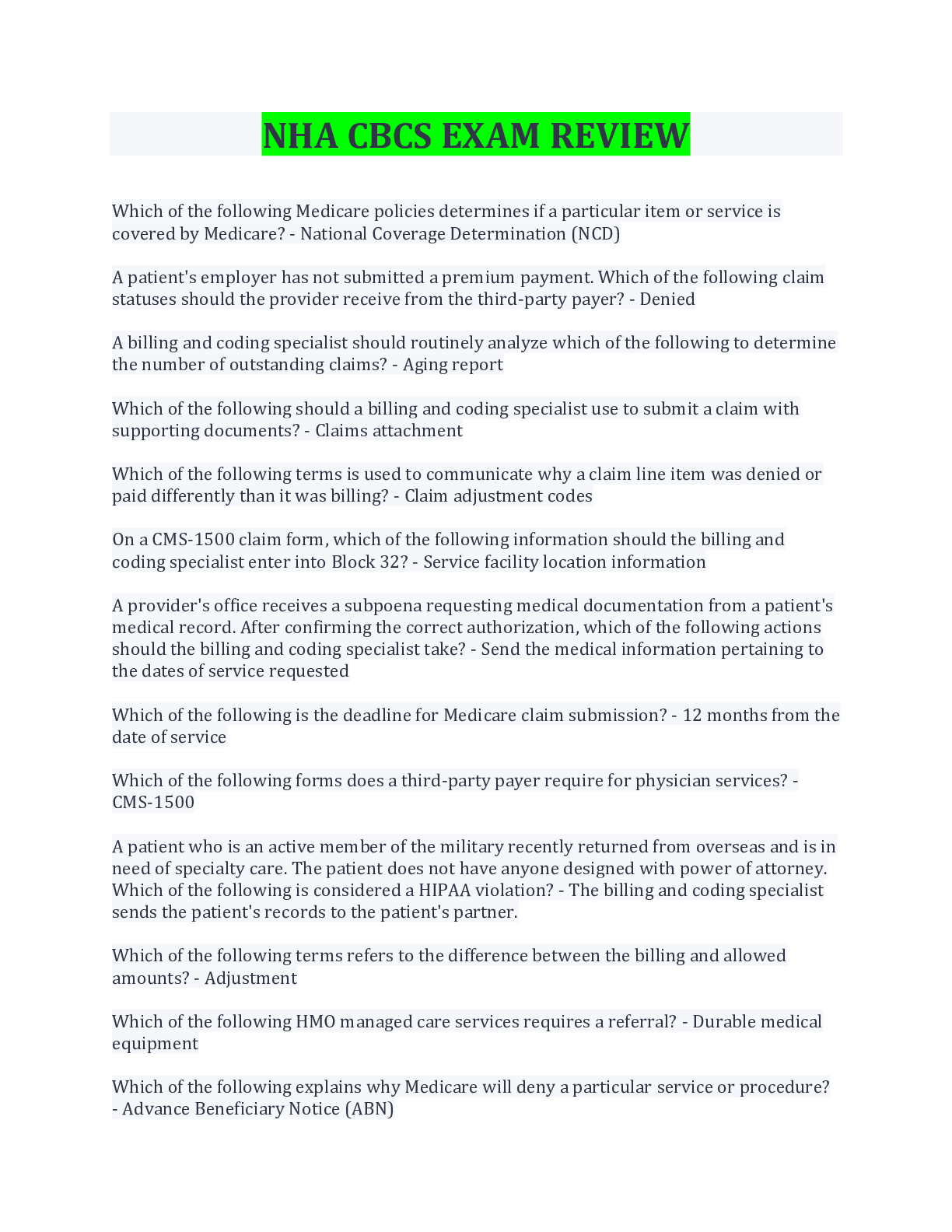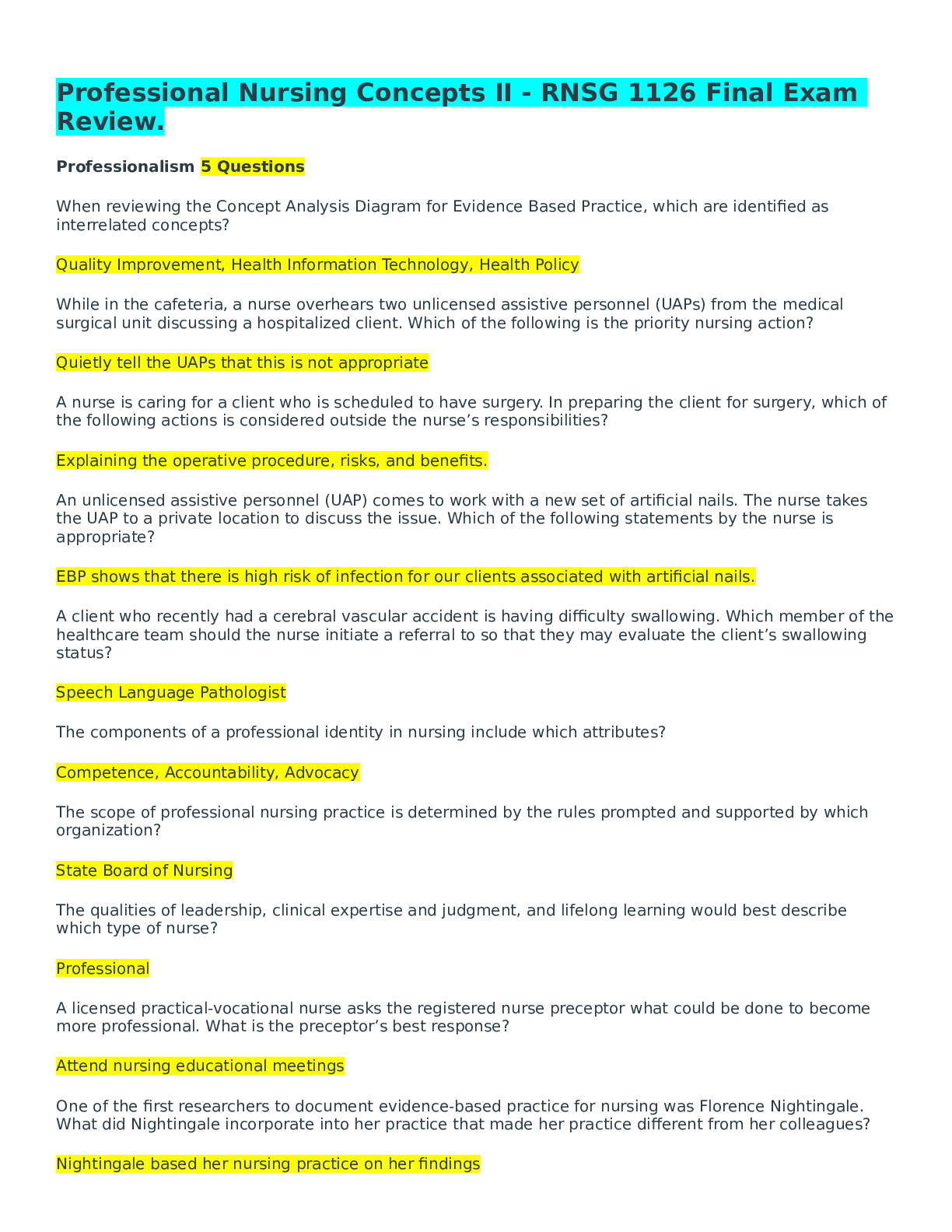MBUS 301 2020 Exam 2 review questions and answers docx 2020 solution
Document Content and Description Below
MBUS 301 2020 Exam 2 review questions and answers docx 2020 solution devry university 1. _____leadership gives purpose and meaning to organizations by anticipating and envisioning a viable future... for the organization and working with others to initiate changes that create such a future. A. Shared B. Strategic C. Lateral D. Bridge E. Supervisory 2. The act of applying a valued consequence to increase a behavior is referred to as: A. positive reinforcement. B. aversive consequence. C. glass ceiling. D. extinction. E. halo effect. 3. A(n) _________is a collection of people who interact to undertake a task but do not necessarily perform as a unit or achieve significant performance improvements. A. group B. environment C. team D. organization E. project 4. In the context of sexual harassment laws in the U.S., which of the following is true? A. Cases of quid pro quo harassment violate Title VII of the Civil Rights Act of 1964, but instances of hostile environment does not. B. Women are protected under Title VII of the Civil Rights Act of 1964, but not men C. Men are protected under Title VII of the Civil Rights Act of 1964, but not women D. “Hostile work environment” standard applies to same-sex harassment, as well as to non-gender related cases. E. Cases of hostile environment violate Title VII of the Civil Rights Act of 1964, but cases of quid pro quo harassment does not. 5. Which of the following steps is a responsibility of the chief information officer? A. Developing new technology B. Finding new ways to produce old products C. Searching for support and acceptance for a new idea D. Identifying ways that technology can support the company’s strategy E. Developing skills needed to install and operate new technology 6. The top management of a company determined that their end-of-year bonuses would not be given due to low sales. Sarah, a department manager, informed her staff that even high-performing employees should not expect a bonus. Sarah’s ______power was limited by the decision of the top management. A. legitimate B. reward C. expert D. referent E. coercive 7. Which of the following is a characteristic of a traditional work environment? A. Managers and team members jointly determine and plan the work. B. Rewards are based on individual performance. C. Jobs require broad skills and knowledge. D. Cross-training is the norm. E. Most information is freely shared at all levels. 8. Instances of withdrawing or failing to provide a reinforcing consequence is referred to as: A. negative reinforcement B. positive reinforcement C. extinction D. group think E. egocentrism 9. The entire process of understanding and appreciating employee differences to build a more effective and profitable organization is known as: A. minority recruiting B. managing diversity C. ethnicity selection D. sugging E. heckling 10. Which of the following is true of a world-class organization? A. It merely strives for improvement. B. It applies the best and latest knowledge and ideas. C. It has a lofty, impossible, unnecessary goal. D. It focuses on competition instead of profits. E. It enforces rigid rules and regulations for employees. 11. Which of the following is a characteristic of a new team environment? A. Everyone works to continuously improve methods and processes. B. Managers determine and plan the work. C. Jobs are narrowly defined. D. Cross-training is viewed as inefficient. E. Managers determine “best methods.” 12. The theory proposing that people will behave based on their perceived likelihood that their effort will lead to a certain outcome and on how highly they value that outcome is known as: A. expectancy theory. B. reinforcement theory. C. path-goal theory. D. equity theory. E. law of effect. 13. According to the trait approach to leadership, a(n)___________leader overcomes obstacles, makes decisions despite uncertainty, and instills confidence in others. A. self-confident B. legitimate C. autocratic D. coercive E. referent 14. A leadership perspective that attempts to identify what good leaders do – that is, what behaviors they exhibit, is known as the: A. behavioral approach. B. trait approach. C. transformational leadership. D. strategic approach. E. situational approach. 15. The ________________refers to the belief that things must be either A or B and cannot be both. A. devil’s advocate B. innovator’s dilemma C. just-in-time manufacturing D. make-or-buy decision E. “tyranny of the or” 16. _______leadership seeks information, opinions, and preferences, sometimes to the point of meeting with the group, leading discussions, and using consensus or majority vote to make the final choice. A. Democratic B. Directive C. Lateral D. Shared E. Autocratic 17. Clara, a new recruit at Blue International, was encouraged to join the official group of minority employees to discuss the challenges and opportunities at Blue International. Clara found the group to be helpful because the other group members were able to communicate to her the norms and culture of the organization. This, in turn, enabled her to adjust to the organization more quickly and effectively. This is an example of: A. an association of whistleblowers. B. an employee support group. C. an informal group. D. grapevine communication. E. haptic communication. 18. Valence is best defined as: A. the perceived likelihood that performance will be followed by a particular outcome. B. the value that expected outcomes hold for the person contemplating them. C. any consequence resulting from performance. D. the perceived likelihood that employees’ efforts will enable them to attain their performance goals. E. the likelihood that a person would repeat an action after receiving positive reinforcement. 19. __________teams work toward a one-time product, disbanding once their work is completed. A. Virtual B. Management C. Work D. Transnational E. Project and development 20. ________is a systemwide application of behavioral science knowledge to develop, improve, and reinforce the strategies, structures, and processes that lead to organization effectiveness. A. Organizational development B. Management myopia C. Outplacement D. Groupthink E. Performance 21. Grace was refused a job, in spite of the fact that she had all the required qualifications. The reason for this rejection was that she reacted negatively to an illicit comment on her dressing made by her interviewer. Based on the given information, it would be most accurate to say that Grace is a victim of: A. sexual harassment. B. nepotism. C. social loafing. D. whistleblowing. E. sugging. 22. _________teams are physically dispersed and communicate electronically more than face-to-face. A. Parallel B. Project and development C. Work D. Management E. Virtual 23. According to Maslow’s need hierarchy: A. one can never be fully satisfied. B. higher-level needs are more important than lower-level needs. C. people are motivated to satisfy lower-level needs before higher level needs. D. once a need is satisfied it becomes a powerful motivator. E. unsatisfied needs will not motivate performance. 24. In the context of the research program conducted at the University of Michigan on the impact of leaders’ behavior on job performance, demonstrating trust and confidence, being friendly and considerate, showing appreciation, and keeping people informed is known as __________behavior. A. relationship-oriented B. participative C. directive D. strategic E. task-oriented 25. ___________interventions, an organization development technique, include attracting good people, setting goals, and appraising and rewarding performance. A. Strategic B. Technostructural C. Human process D. Tactical E. Human resources management 26. The leadership perspective that proposes that universally important traits and behaviors do not exist and that effective leadership behavior varies from circumstance to circumstance is known as the: A. situational approach. B. behavioral approach. C. trait approach. D. directive approach. E. charismatic approach. 27. In _________teams, workers are trained to do all or most of the jobs in the unit, they have no immediate supervisor, and they make decisions previously made by first-line supervisors. A. traditional B. quality C. semiautonomous D. self-managed E. virtual 28. The _________model of leadership uses the basic situational approach of assessing the situation before determining the best leadership style. A. laissez-faire B. traits C. Fiedler’s contingency D. task-motivated E. Vroom 29. Daphnie has recently been denied a promotion. This is the third time she was turned down, but “that’s just the way things go.” After this last disappointment, Daphnie took a good hard look at her company. She found that only two women candidates have been promoted to upper management positions, in the company’s entire history. Which of the following factors is most likely obstructing Daphnie’s career growth? A. A diversity-oriented employer. B. A lack of communication skills. C. Glass ceiling effect. D. Whistleblowing activities E. Implementation of affirmative actions. 30. Alderfer’s ERG theory primarily focuses on: A. existence needs, relatedness needs, and growth needs. B. existentialism, relativity, and governance. C. employment, recruitment, and gain sharing D. Team members realize satisfaction of their family needs. E. expectancy, risk, and growth 31. Who developed force-field analysis? A. Lawrence Ellison B. Kurt Lewin C. Frederick Taylor D. Peter Drucker E. Adam Smith 32. A difference between Maslow’s need hierarchy and Alderfer’s ERG Theory is that: A. ERG theory states that various needs operate simultaneously. B. Maslow’s hierarchy has more scientific validity. C. Maslow’s hierarchy states that once a need is satisfied, it acts as a powerful motivator. D. ERG theory focuses on the five levels of needs. E. ERG theory reminds managers of the types of reinforcers that can be used to motivate people. 33. In the ______________stage of team development, hostilities and conflict arise, and people jockey for positions of power and status. A. performing B. declining C. storming D. deteriorating E. forming 34. Which of the following is the main reason behind the projected slowdown in the pace of growth of the labor force in the U.S. and other developed countries? A. Lower birth rates B. Lower mortality rates C. Emergence of the baby boom generation D. Increasing diversity in the workforce E. Undertaking of affirmative action 35. The rewards given to a person by the boss, the company, or some other person are known as: A. halo effect. B. personalized power. C. extrinsic reward. D. hygiene factor. E. procedural justice. 36. Which of the following is most likely to help employers in preventing an exodus of talent and retaining skilled and knowledgeable older workers? A. An emphasis on physical effort B. Phased retirement programs C. Enhanced severance packages D Limiting the availability of paid sabbaticals E. Limiting training for older employees 37. The act of changing a task to make it inherently more rewarding, motivating, and satisfying for the concerned people is referred to as: A. task significance. B. job enrichment. C. task identity. D. job enlargement. E. halo effect 38. In a __________leadership approach, the team leader seeks input from group members for decision, provides assignments and experiences to develop members’ skills and abilities, coordinates group effort, and the like. A. team B. participative C. supervisory D. strategic E. tactical 39. In the context of Fiedler’s contingency model of leadership effectiveness, leadership styles were measured with an instrument assessing the leader’s _______. A. drive B. psychological maturity C. self-confidence D. task orientation E. least preferred co-worker 40. In the context of Herzberg’s two-factor theory, characteristics of the workplace, such as company policies, working conditions, pay, and supervision, that can make people dissatisfied are referred to as: A. Hygiene factors. B. motivators. C. outcomes. D. expectancies. E. positive reinforcers. 41. A study by the Department of Labor’s Glass Ceiling Institute showed that the stock performance of firms that were high performers on diversity-related goals were ______that of other firms. A. over twice as high as B. actually lower than C. no higher than D. approximately seven times higher than E. over twenty times lower than 42. __________occurs when a tightly knit group is so cooperative that agreeing with one another’s opinions and refraining from criticizing others’ ideas become norms. A. Cohesiveness B. Parading C. Groupthink D. Probing E. Brainstorming 43. _________is a style of dealing with conflict involving cooperation on behalf of the other party but not being assertive about one’s own interests. A. Compromise B. Competing C. Avoidance D. Collaboration E. Accommodation 44. The process of sharing power with employees, thereby enhancing their confidence in their ability to perform their jobs and their belief that they are influential contributors to the organization is known as: A. empowerment B. job enlargement C. growth need strength D. task significance E. task identity 45. A leader who has ______power has certain knowledge; people comply because they believe in, can learn from, or can otherwise gain from that knowledge. A. expert B. coercive C. reward D. referent E. legitimate 46. The practice of using a fair process in decision making and making sure others know that the process was as fair as possible is referred to as: A. procedural justice B. task identity. C. job equity. D. job enlargement E. sugging. 47. Under which of the following conditions can social loafing be avoided? A. Group members do not know each other. B. Members are unable to observe and communicate with one another. C. The task is unimportant to the people working on it. D. Clear performance goals exist. E. The culture supports individual work. 48. For motivation to be high: A. expectancy must be high. B. instrumentalities must be low. C. total valence of all outcomes must be low. D. goals should be unattainable. E. goals should conflict with people’s personal values. 49. Companies with a reputation for providing opportunities for diverse employees are most likely to: A. have a disadvantage in the labor market. B. have a homogenous workforce. C. take greater time in responding to environmental changes. D. attract and retain motivated employees. E. facilitate groupthink among its employees. 50. _________means anticipating and preparing for an uncertain future. A. Technology audit B. Product innovation C. Proactive change D. Disruptive innovation E. Differentiation MBUS 301 Spring, 2020 Exam #2 Please read, sign, and follow the GMU honor code. This exam consists of 50 multiple-choice items for total possible points of 50. You have two hours to take this exam. • Mark your answers on a Scantron form clearly in ink, then scan the form into your computer and e-mail it to me along with this cover sheet with your signature. • If you don’t have the ability to scan the cover sheet with your signature, type your signature. • You can also take a picture of the Scantron form and e-mail the picture to me. • If you do not have a Scantron form, list the number of the question on a blank piece of paper and your answer beside it. Don’t forget your name. • Make certain to e-mail this cover sheet along with your answers. • Make certain your name is on every piece of paper you e-mail to me. This is important should your answers get separated from your e-mail. • I have thought of an opportunity to give everyone two points extra credit. I’ll give you that information over the weekend. Student members of the George Mason University community pledge not to cheat, plagiarize, steal, or lie in matters related to academic work. I agree to abide by this Honor Code for this test. ______________________________________________ Signature Kulpinder Dhillon ______________________________________________ Name Instructions: 1. Write the following information on your Scantron form: • Name • Class (MBUS 301) and Instructor’s name (Medlock) 2. Please turn off and keep out of sight any electronic devices and remove course materials from view. Good luck! [Show More]
Last updated: 1 year ago
Preview 1 out of 6 pages
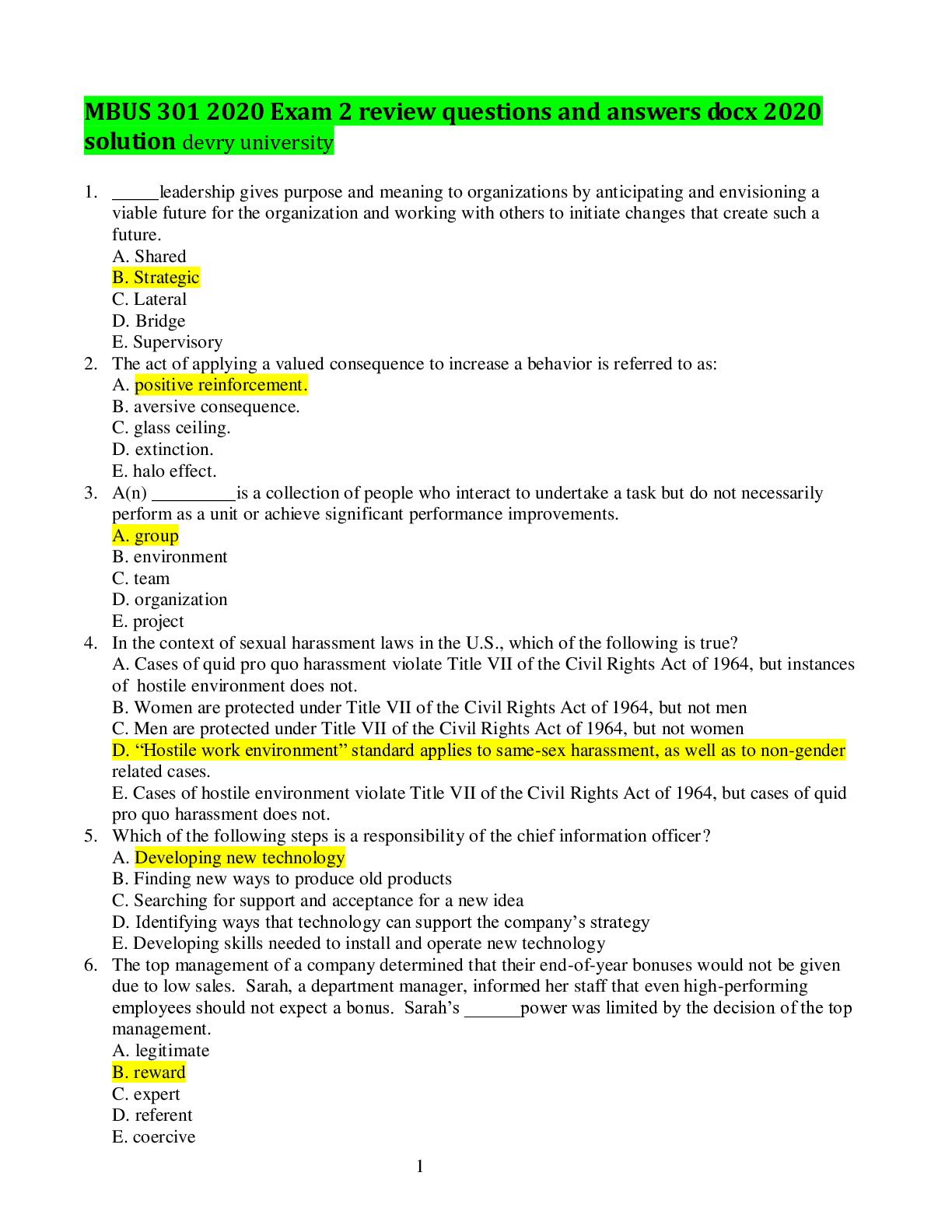
Reviews( 0 )
Document information
Connected school, study & course
About the document
Uploaded On
Oct 24, 2020
Number of pages
6
Written in
Additional information
This document has been written for:
Uploaded
Oct 24, 2020
Downloads
0
Views
60

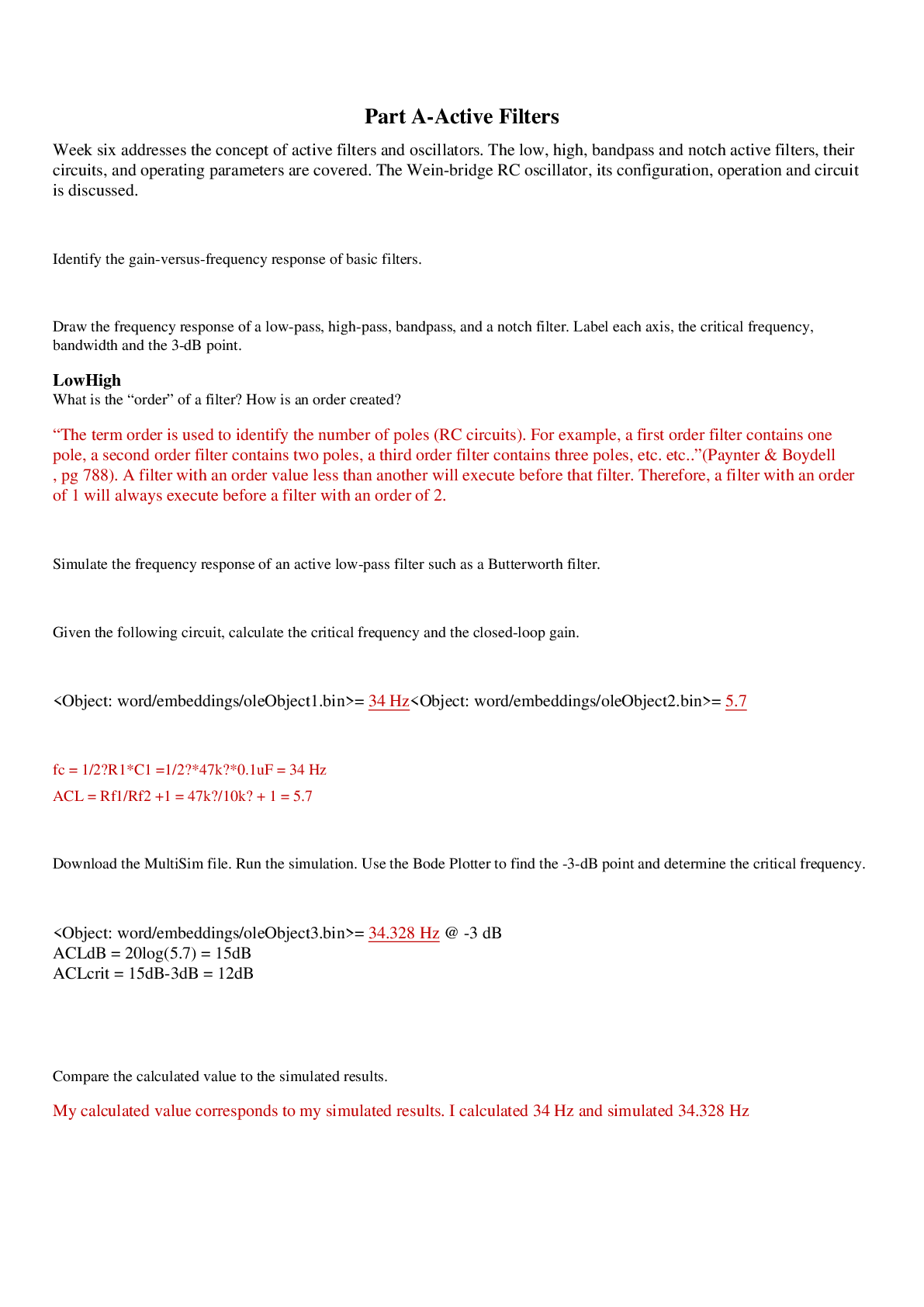
 q and s (1).png)
.png)
 ans.png)
